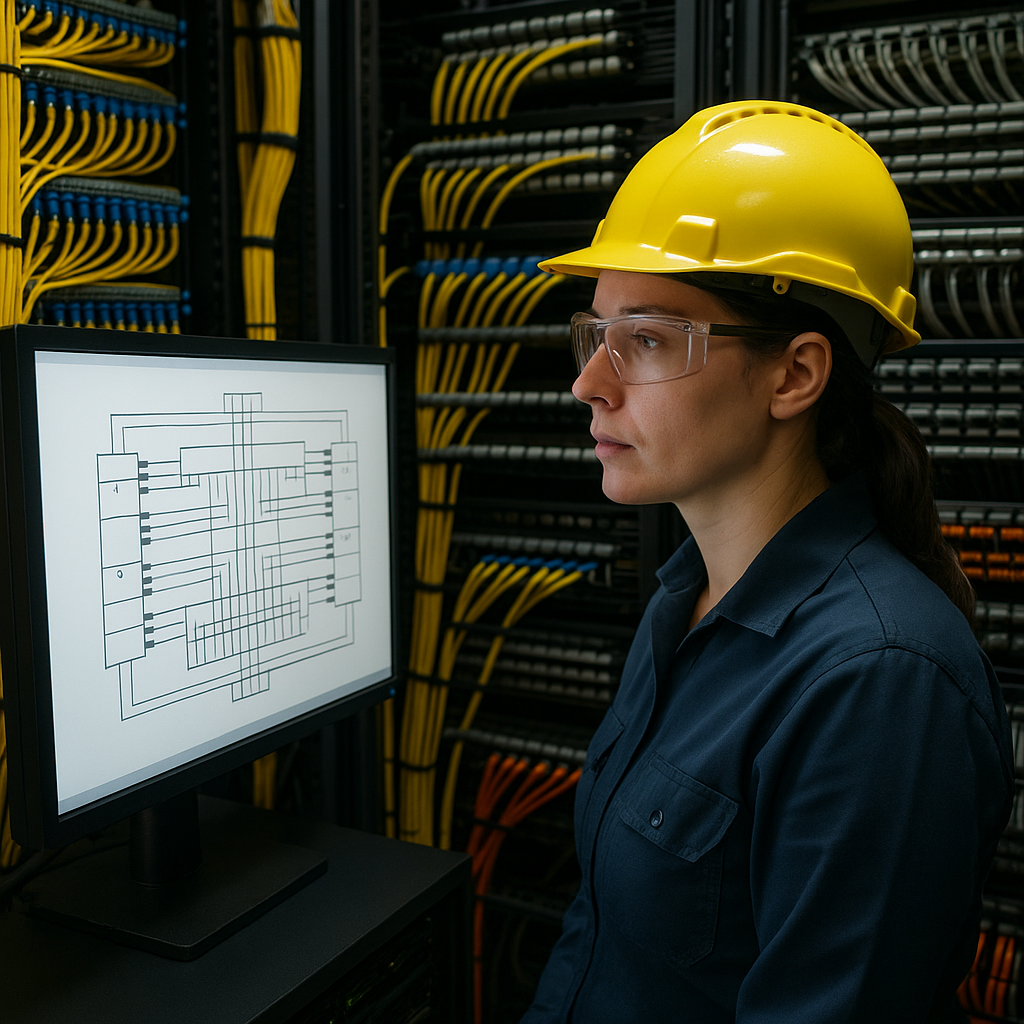Structured Cabling Color Codes: What Each Cable Color Means
In a structured cabling system, knowing what each cable does shouldn't take guesswork. With the right color code standard in place, a technician can...
5 min read
 Kevin Murphy
:
Nov 10, 2025 6:30:00 AM
Kevin Murphy
:
Nov 10, 2025 6:30:00 AM
The modern commercial building is no longer a passive structure of steel and glass; it's a dynamic, intelligent environment. Smart building technologies—from IoT sensors monitoring air quality to IP-based security cameras and automated HVAC systems—are converging to create more efficient, secure, and user-friendly spaces. But this digital nervous system is only as reliable as the physical infrastructure that supports it. Traditional, point-to-point wiring methods are simply not equipped to handle the data density, power requirements, and scalability that smart buildings demand.
At Turn-Key Technologies, we've spent decades designing and deploying the foundational infrastructure that powers mission-critical operations. We understand that for a smart building to deliver on its promise, it requires a meticulously planned structured cabling system. This approach provides an organized, standardized, and future-proofed telecommunications infrastructure that supports all the data and power delivery needs of today’s building systems and those of tomorrow. It moves beyond chaotic wiring closets to create a manageable, high-performance asset.
The shift from basic data connectivity to integrated building automation exposes the critical flaws of legacy wiring practices. An ad-hoc approach creates a brittle and inefficient infrastructure that is expensive to manage and nearly impossible to scale effectively.
Historically, each building service—telecommunications, security, HVAC, and audiovisual—operated in a silo with its own proprietary cabling. This results in a tangled mess of different cable types and disconnected pathways, making management a nightmare. Troubleshooting a single connectivity issue can involve tracing wires through cluttered, undocumented bundles, leading to extended downtime and high labor costs for even simple changes.
Legacy cabling, such as Cat 5e, lacks the bandwidth to support the data-intensive applications common in modern smart buildings. High-resolution video surveillance, wireless access points serving hundreds of users, and vast sensor networks require the high-speed data transmission offered by newer standards. Furthermore, these older cables are not designed to handle the higher power levels of modern Power over Ethernet (PoE), which is essential for efficiently powering devices like smart lighting and access controls.
Adding a new security camera or environmental sensor in a traditionally wired building is often a major project, requiring new cable to be pulled all the way back to a central closet. This process is disruptive, costly, and slow. A properly designed structured cabling system, however, anticipates future growth, making it simple to add or move devices without undertaking a massive rewiring project.
A robust cabling system for intelligent buildings is built on a foundation of standardized components and forward-thinking design. This cabling architecture ensures that bandwidth, power, and connectivity are available wherever they are needed, supporting the seamless integration of countless building devices.
Category 6A (Cat 6A) cabling is the baseline standard for new smart building installations. It supports data transmission speeds up to 10 Gbps and operates at higher frequencies, providing the necessary bandwidth for today’s applications and a clear pathway for future technologies. Its improved construction also offers better protection against alien crosstalk, an important consideration when bundling dozens of cables that may be carrying high-power PoE.
Power over Ethernet delivers both data and DC power over a single twisted-pair Ethernet cable, radically simplifying the installation of smart devices. The latest IEEE 802.3bt standard can deliver up to 90 watts of power, sufficient for devices like PTZ security cameras, digital signage, and even small monitors. This consolidation of data and power eliminates the need for a nearby electrical outlet and the cost of hiring an electrician for every new device installation.
While copper cabling excels at horizontal runs to end devices, fiber optic cable is the clear choice for the building’s network backbone. A fiber backbone connects telecommunications rooms across floors or between buildings on a campus, offering immense bandwidth capacity over very long distances. It is also completely immune to electromagnetic interference (EMI), ensuring stable, high-speed performance in electrically noisy environments like mechanical rooms and elevator shafts.
A zone cabling architecture is a highly flexible design and implementation strategy ideal for open-office layouts and adaptable spaces. Instead of running every cable back to a central closet, horizontal cabling is run from the telecommunications room to a consolidation point within a specific "zone." Shorter, more manageable cables then connect devices within that zone to the consolidation point, making future moves, adds, and changes faster and less disruptive. This follows the principles of a understanding structured cabling: a comprehensive guide to create a modular and easily managed network.
A successful cabling installation is the result of meticulous planning that aligns the physical infrastructure with the building’s long-term operational goals. Adhering to established best practices ensures the final cabling system is reliable, scalable, and provides maximum return on investment.
Compliance with industry standards is non-negotiable for ensuring system performance and interoperability. Organizations like the Telecommunications Industry Association (TIA) and BICSI provide detailed guidelines for the design, installation, and testing of structured cabling systems. Following these standards ensures that components from different manufacturers will work together and that the cabling architecture will support both current and next-generation applications.
A comprehensive system design begins with a detailed plan for the location of every network-connected device. This includes mapping out locations for wireless access points, security cameras, thermostats, and occupancy sensors. As of late 2025, best practices often involve creating a "digital ceiling" grid, which pre-wires zones in the ceiling plenum to provide ubiquitous data and power ports, ensuring that future devices can be added anywhere with ease.
Effective cable management is crucial for performance and safety. Pathways like cable trays and conduits must be properly sized to accommodate the initial installation plus projected future growth, typically a 40-50% fill ratio. With the increased use of high-power PoE, heat dissipation within cable bundles is a major concern. Following guidelines from the National Electrical Code (NEC) regarding bundle size and cable separation is essential to prevent performance degradation and ensure safety.
Investing in a well-planned structured cabling system from the outset pays significant dividends throughout the building’s lifecycle. The benefits extend far beyond simple connectivity, impacting business operations, maintenance costs, and the ability to adapt to new technologies.
An organized and well-documented structured cabling system dramatically simplifies troubleshooting. Technicians can quickly identify and resolve issues, minimizing downtime that could impact critical building operations like security systems or energy management. This centralized approach reduces the labor costs associated with managing the chaotic wiring of disparate, legacy systems.
A key benefit of this approach is its inherent scalability. The use of zone cabling and installing higher-performance cable like Cat 6A ensures the building infrastructure is ready for future growth. For a recent corporate campus client, we implemented a zone architecture that allowed them to add a suite of environmental sensors two years after the initial build-out with minimal disruption and cost, a task that would have been prohibitive with their previous point-to-point system. You can see examples of these principles in action when you explore our case studies.
Ultimately, the cabling infrastructure is the foundation for the smart building’s core functions. Reliable connectivity for building automation systems allows for optimized energy management through smart HVAC and lighting controls. High-performance data transmission ensures security systems operate flawlessly. For occupants, this translates into a comfortable, safe, and productive environment where wireless connectivity is seamless and building services are responsive.
The convergence of building systems over a single IP network requires a unique blend of expertise. The design and implementation of a structured cabling system for a smart building demands a deep understanding of IT network architecture, building codes, and the specific requirements of modern automation technologies.
A properly executed structured cabling installation is not an IT expense; it is a long-term investment in the building itself. This foundational layer dictates the capability, reliability, and future-readiness of every smart technology you deploy. It centralizes control, simplifies management, and provides the scalable backbone needed for the intelligent structures of the 21st century.
If you are ready to build a future-ready foundation for your intelligent building, we can help. If you have questions about your specific project, don't hesitate to get in touch. Request a smart-building design consultation with our experts today.

Kevin has been with Turn-key Technologies since 2012, overseeing cabling teams and managing projects from concept to completion. With deep expertise in structured cabling installations—including fiber optics, Cat5/5e/6/6a, and coax systems—he works closely with clients and engineers to deliver reliable, high-quality solutions on time and on budget.
Certifications:
NJ Division of Consumer Affairs
• Uniform & Construction Code
• Residential Fire Alarm Systems
• Smoke Detection Systems
• NJ Barrier Free Subcode
• ADA & Licensing Law
NYS Licenses
• Security & Fire Alarm License
• Electrical Training Center Fire Alarm Certification
BICSI & Technical
• Designing for PoE Lighting
• Fiber Optic & Connector Termination
• Firestop 101
Other Certifications
• OSHA 30-Hour Construction Safety
• Verkada Certified Engineer
• Avigilon Access Control Manager 6

In a structured cabling system, knowing what each cable does shouldn't take guesswork. With the right color code standard in place, a technician can...
7 min read
Your team complains about slow file downloads, lagging video calls, and random network drops. You’ve upgraded your internet connection and invested...

4 min read
A disorganized data center rack full of tangled network cable runs is a direct liability to your network's stability. When cables used for...